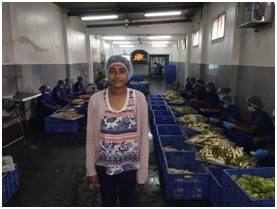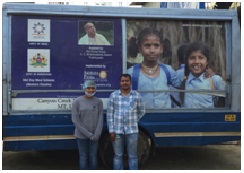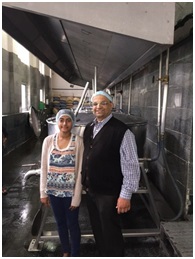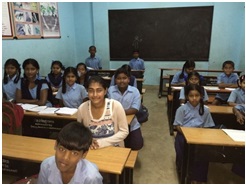Contribute
| Mission Hunger |
Yusra Syed
12/02/2015
This summer, I had the incredible opportunity to travel to my homeland, Bangalore, India, and visit Akshaya Patra kitchens to witness the work they do up close. On my trip, I visited two kitchens, the smaller one located in the ISKCON Temple campus in North Bangalore and the larger one in South Bangalore.
When I first arrived at the larger facility, I was surprised to see that it resembled a factory. Kale Gurunadha, an executive of the kitchen, gave me a tour. There were different rooms designated to various operations of food preparation. I found it fascinating to see the different preparation areas and the sequence that the meal preparation follows. Room 1 was for the preparation of vegetables- cleaning, peeling, and cutting. Room 2 was an area designated to clean dirty dishes.
“Hunger and malnutrition are in fact the number one risk to health worldwide — greater than AIDS, Malaria and Tuberculosis combined†(World Food Programme). Let us take a minute to compare the problem of hunger and malnutrition to the other conditions listed above. Seriously, take a minute and think about it. What are their differences? Hunger is a problem that can be solved. Diagnosing AIDS, Malaria, and Tuberculosis requires medication, time, patience, and funds. Hunger and malnutrition can be addressed with healthy, balanced meals- food. Akshaya Patra not only strives to solve the problem of hunger in India, but also motivates students to attend school and learn, so their futures are brighter.
On my tours of these kitchens, I was surprised that while everything is prepared in large quantities, quality is not compromised. Feeding hungry students in India is a substantially large operation, but Akshaya Patra takes time to make sure the food is clean, prepared well, and delicious. The typical meal served to students throughout the week is sambar, a lentil and vegetable stew and steamed white rice. The vegetables in the sambar and the spice mix change everyday to vary the flavors. The dish seems simple, but the flavors in the sambar are something you don’t find in the US. On Wednesdays and Saturdays, special meals, such as bisebelebath, a traditional Karnataka dish made of lentils, rice and vegetables or rice pulao, are served.
I followed the Akshaya Patra delivery truck to Government Junior Primary School, a local school in North Bangalore. I noticed the excitement on the students faces as they got ready for their hot lunch; they washed their hands, plates and sat in straight lines eagerly. I served the students bisibelebath and dessert and watched them finish a plate of food in just a few minutes and get ready for the second serving. Yes, the students are served seconds as every school is sent some extra food to ensure that the students with a larger appetite don’t go hungry for the rest of the day. Some of them may not get another complete meal for the day. I could see the smile on their faces as they enjoyed the delicious Bisibelebath. This was a very heartwarming experience, and I am so glad that I was able to see happiness in the boys and girls before and after their meal.
Thank you Akshaya Patra for nourishing their bodies and minds to put their best efforts in their schoolwork and athletics. Now I believe that this is the best way to attract children to attend schools and increase the literacy rate in the suburbs. Our next challenge would be to figure out a cost-efficient way to serve the children in villages and rural areas far away from the cities.
You may also access this article through our web-site http://www.lokvani.com/

Yusra Syed at the vegetables preparation section inside Akshaya Patra Kitchen

Yusra Syed with Kale Gurunadha, Quality Assurance Manager, Akshaya Patra, Bangalore South

Yusra Syed with Anil Kumar, Head of Akshaya Patra in Bangalore

Yusra Syed in a class at Government Junior Primary School in North Bangalore